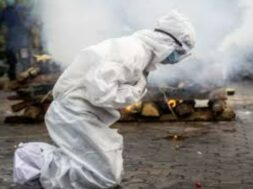
Covid explosion: Finally, China admits 60,000 deaths in a month!
Virendra Pandit
New Delhi: A week before the worried Chinese celebrate their Lunar New Year on January 22, and amid hundreds of millions of people crisscrossing China for this 40-day-long event, Beijing, on Saturday last weekend, admitted witnessing almost 60,000 Covid-related deaths in a month, as the tides of deadly infections swept the country.
The media, quoting China’s National Health Commission (NHC), said that 59,938 people died at hospitals from Covid-related causes between December 8 and January 12. The World Health Organization (WHO) said it is analyzing the latest data and urged China to share more detailed information, including on sub-variants of the coronavirus circulating throughout the nation.
According to a statement on Saturday, WHO’s Director-General Tedros Adhanom Ghebreyesus reiterated the importance of China’s deeper cooperation and transparency during his talks with NHC Director Ma Xiaowei.
“A more timely, open, and transparent sharing of Covid statistics with the Chinese people and the rest of the world is long overdue,” said Jin Dong-yan, a virologist at the University of Hong Kong.
The killer virus has been spreading at a faster pace in China after the government relaxed controls in November and abruptly abandoned its Covid Zero policy in December.
As China officially stopped sharing data and mostly adopted a narrower definition of a Covid fatality, it became difficult to gauge the impact of the change — only those who die from respiratory failure caused by the virus were counted as Covid deaths, not those whose comorbidities caused death after they contracted infections.
Reports on social media of surging deaths across parts of the country suggest the actual number of deaths resulting from infection may be far higher. For weeks, reports and videos from China went viral globally, suggesting that hospitals, mortuaries, and crematoria were overwhelmed with victims.
Economists at Barclays in December 2022 predicted China’s fatality rate from an Omicron wave would be about 0.4 percent among the unvaccinated and 0.02 percent among the fully vaccinated. That would indicate that Covid-related deaths during the current wave in China’s 1.4 billion population ultimately may be many times higher than the 60,000 so far reported.
A study published last Friday in Nature Medicine said that 76 percent of Beijing’s 22 million population were probably infected with the virus by December 22 and that figure would rise to 92 percent by the end of January. It said the reproductive rate — how many people on average one person with the virus infects — increased to 3.44 following the policy shifts.
Hong Kong University’s virologist Jin said, in addition to the number of deaths of patients admitted to hospitals, China should provide the total number of Covid-related deaths, including those who died from worsening underlying diseases. It should also give the infection rate in the general population and among elderly people, as well as hospital and ICU admission and occupancy rates.
The NHC said the average age among the deaths reported Saturday was 80.3 years and over 90 percent of the deceased had other diseases including cardiovascular diseases, advanced tumors, and metabolic diseases. Elderly people are more prone to respiratory diseases and aggravation of cardiovascular diseases in the winter, and Covid infections aggravate the situation, said commission official Jiao Yahui.
With this Covid explosion in China, several countries are now worried. For them, a key concern is whether the possible emergence of a major new variant resistant to current vaccines could reignite the global pandemic. Some countries have tried to ward it off and imposed restrictions on Chinese travelers.
The absence of comprehensive information from China makes it “understandable” that other nations are taking steps they believe will protect their populations, the WHO chief said two weeks ago.
Still, China has not reported any dangerous Covid mutations in the six weeks since it abruptly abandoned the rigid curbs in early December 2022.
While the government has largely abandoned testing and tracking of cases, it has submitted data on nearly 1,000 genetic sequences from over a dozen provinces to the GISAID consortium that tracks variants, since officials started rolling back the Covid Zero approach late in November. All the strains closely resemble variants found elsewhere in the world, according to GISAID data.
The NHC chief, in a statement, said China will continue to support the role of the WHO in pooling international efforts to fight the virus.
Reports said China’s Covid surge may be peaking, at least in big cities. At a recent seminar in China, Zeng Guang, former chief scientist at the Chinese Center for Disease Control and Prevention, said that parts of the country are approaching the peak of their virus waves and life in some major cities is slowly returning to normal. But he warned that many rural areas have yet to see infections surge.
That is where the next global challenge might emerge.














